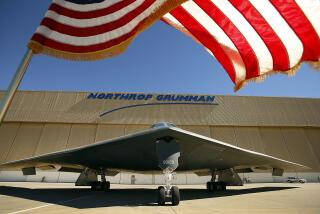Northrop First-Quarter Profit Sharply Lower; Weapons System Cited
- Share via
Northrop Corp. reported sharply lower earnings on Wednesday, a decline it attributed to a huge one-time tax benefit in the first quarter a year earlier. But analysts said the drop also reflects costly development problems with a weapons system for the Air Force.
In other results in the aerospace industry, Rockwell International Corp. reported higher second quarter earnings, due largely to the sale of a division; and General Dynamics Corp. said it had a 12% decrease in first-quarter profit, due in part to declining earnings in its military aircraft operation, and GM Hughes Electronics said earnings for the first quarter fell slightly.
Earnings Lower Than Expected
Northrop, which was recently indicted for defense fraud, said Wednesday that it earned $9.7 million on revenue of $1.28 billion in the first quarter, compared to earnings of $139.6 million on revenue of $1.37 billion during the first three months of last year.
The company said its year-earlier quarterly results included a $135.1-million one-time tax benefit that resulted from a restatement of deferred taxes. Without the tax benefit in 1988, Northrop would have earned $4.5 million.
Aerospace industry analysts said Northrop’s earnings were much lower than expected, largely due to an unexpected $26-million write-off related to the company’s radar jammer for the F-15 fighter.
Northrop made a similar provision in the fourth quarter of last year for development of the system, called the ALQ-135, but didn’t reveal the amount of the write-off for that quarter. At the time, analysts thought the write-off indicated that Northrop had largely solved its problems with that system.
“It indicates ongoing development problems with it,” said Lawrence M. Harris, an aerospace analyst with Bateman Eichler Hill Richards, a Los Angeles investment firm.
Also somewhat disappointing, analysts said, was the drop in Northrop’s order backlog to $4.6 billion from $5.4 billion a year ago. Harris said the decline wasn’t a major concern, however, since last year’s number probably reflected to some extent a $2-billion order for the stealth bomber received in late 1987.
Northrop blamed its first quarter sales decline on lower revenue from its B-2, or stealth, bomber program and on lower sales of parts for the MX Peacekeeper missile, as well as lower sales and fewer deliveries of parts for the F/A-18 Navy fighter. Northrop, however, reported higher profits in its aircraft business due to an increase in sales for parts for Boeing 747s.
B-1B Production Ended
Rockwell, based in El Segundo, said profit rose 24% in its second fiscal quarter, largely because of a $100-million after-tax gain on the sale of Rockwell’s measurement and flow division, which makes meters and valves, to BTR Dunlop Inc., the U.S. subsidiary of BTR PLC, the British maker of sports and industrial products.
The aerospace company said Wednesday that sales declines due to the end of production of the B-1B bomber were offset by higher revenue on space shuttle, space station and “Star Wars” programs, as well as gains in the company’s electronics and automotive divisions.
Rockwell earned $270.7 million in its second quarter, up from $218.4 million in the second quarter of 1988. Sales for the quarter ended March 31 were $3.16 billion, up from $3.04 billion a year earlier.
GM Hughes Electronics, which operates Hughes Aircraft, said its first-quarter earnings fell to $210 million from $252 million during the first three months of 1988. Meanwhile, revenue rose to $3 billion during the first quarter, up from $2.7 billion during the same period a year ago.
The company said that operating revenue for Hughes Aircraft, and for its Delco Electronics division, increased over a year ago. The company said that, despite lower overall profits, pretax profits increased by 5% to $298.5 million from $283 million due to a cost reduction program.
General Dynamics reported earnings for the first quarter of 1989 declined to $75.4 million on revenue of $2.36 billion, compared to net earnings of $85.7 million on revenue of $2.42 billion during the same period last year.
The decline in operating earnings in the military aircraft segment resulted from lower volume and a reduction of the earnings rate in the F-16 program, said Stanley C. Pace, chairman and chief executive of the St. Louis-based firm.
Those trends reflected lower margins on recent contract awards as well as cost increases resulting from simultaneous production of more than 20 versions of the aircraft, he said.
More to Read
Inside the business of entertainment
The Wide Shot brings you news, analysis and insights on everything from streaming wars to production — and what it all means for the future.
You may occasionally receive promotional content from the Los Angeles Times.










